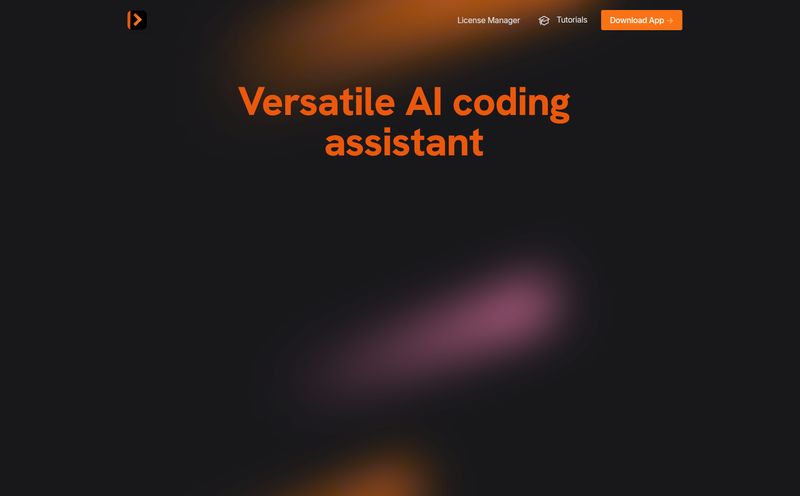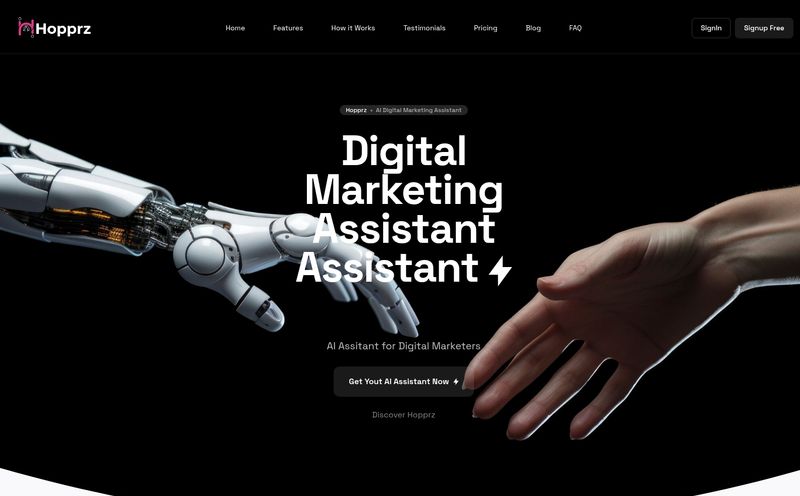We've all been there. Staring at a blank Figma canvas, the cursor blinking mockingly, while a deadline barrels down on you like a freight train. The client wants 'something fresh' for their app, the product manager needs three different concepts by EOD, and your creativity has apparently packed its bags and gone on vacation. It’s the kind of pressure cooker moment that defines a lot of our lives in the digital design and marketing space.
For years, we've had tools to build, but the initial spark—the ideation—has always been on us. Well, the AI wave is here, and it's starting to offer some pretty interesting solutions to that 'blank canvas' problem. I've been keeping a close eye on AI tools that promise to speed up workflows without sacrificing quality. Some are duds, some are novelties, but a few, just a few, feel like they might actually stick. Today, I'm looking at one of those contenders: Galileo AI.
It bills itself as a UI generation platform that creates editable designs from a simple text prompt. Sounds like magic, right? But as a professional who’s seen a lot of tech fads come and go, I’m naturally skeptical. So, I dug in to see if it’s the real deal or just another shiny object.
So, What Exactly Is Galileo AI?
Imagine you could hire a junior designer who is impossibly fast, works 24/7, and can spin up a dozen app screen ideas based on a single sentence you feed them. That’s the core idea behind Galileo AI. You give it a text description—something like, “A sign-up screen for a minimalist coffee subscription app with a clean, earthy color palette”—and it generates a high-fidelity, visually appealing UI design.
But it's not just a one-trick pony. It also claims to turn images into UI, which is a fascinating concept. Think about snapping a photo of a cool menu, a piece of architecture, or even a messy napkin sketch and having the AI translate that vibe into a functional interface. It’s designed to be an accelerator, a tool to get you from zero to sixty on a new project so you can spend more time on the stuff that matters: strategy, user experience refinement, and a final, human polish.

Visit Galileo AI
Putting Galileo AI to the Test: The Core Features
A tool is only as good as what it can do. So, what’s under the hood? I found a few features that are genuinely compelling for anyone in the trenches of web and app design.
From Simple Text to Stunning UI
The main event is, of course, the text-to-UI generation. This is where you get to play director. The quality of your prompt directly influences the output, much like with image generators like Midjourney. It’s a new skill in itself, learning to articulate visual ideas through words. But when you nail it, you can get a fully-fleshed-out design component in seconds. This isn't just about generating a single button; we're talking about entire screens with layout, imagery placeholders, and typography already in place. For brainstorming or creating quick mockups for A/B testing, this is a massive time-saver.
The Figma Connection Is a Game-Changer
Here’s the part that made me sit up and pay attention. Galileo AI designs are exportable directly to Figma. This is, without a doubt, its most critical feature for professionals. An AI that generates pretty pictures is a novelty; an AI that generates pretty pictures inside a fully editable Figma file is a tool. It means you’re not stuck with a static JPG. You get layers, vectors, and text boxes that you can tweak, resize, and integrate into your existing design system. This single feature elevates it from a fun toy to a legitimate piece of the modern design workflow.
And It Even Speaks Code?
For those of us who work closely with developers—or for the full-stack folks who do it all—the code export is another huge plus. Bridging the gap between the final design in Figma and the front-end code is a perennial challenge. While AI-generated code still needs a human eye to ensure it's clean and efficient, getting a solid starting point for React or other frameworks can shave hours, if not days, off of development time. It helps make the designer-developer handoff a little less painful, and we can all appreciate that.
Let's Talk Money: Galileo AI Pricing
Alright, this is where the rubber meets the road. Is it affordable? Galileo AI uses a credit-based system, which feels a bit like an arcade—you pay for your plays. Each generation or edit consumes credits. Here’s a quick breakdown of their plans:
| Plan | Price (Billed Annually) | Key Features |
|---|---|---|
| Standard | $16 / month | 1200 credits/month, Figma & code export, commercial use. Great for freelancers and personal projects. |
| Pro | $32 / month | 3000 credits/month, everything in Standard, plus Private mode to keep client work confidential. |
| Enterprise | Contact for pricing | Unlimited generations, advanced security, priority support. For large teams and agencies. |
The Private mode on the Pro plan is the big differentiator for professionals handling sensitive client projects. You don't want your groundbreaking app design being used to train the model for your competitors, right? So that's a thoughtful addition.
The Good, The Bad, and The AI-Generated
No tool is perfect. In my experience, its' a powerful tool but you have to know its limits. The speed is undeniable. The ability to churn out ideas is fantastic for getting past creative blocks. And the Figma integration, as I’ve said, is brilliant.
However, there are a few things to consider. The credit system means you’re always conscious of how many generations you have left, which can sometimes stifle free-form experimentation. More importantly, they state that refunds are not offered. That's a tough pill to swallow and means you should be pretty sure this is the right tool for you before committing to an annual plan. Also, there's the classic AI trade-off: you're sacrificing some of your granular, moment-to-moment control for speed. The AI might not get your vision exactly right on the first try, and that's where your own design skills come in to refine its output.
Who Is This Tool Really For?
So, who should drop the cash on Galileo AI? I don't see this replacing a senior UI/UX designer. Not by a long shot. The strategic thinking, the deep user empathy, the pixel-perfect polishing—that’s still our domain.
Instead, I see it as an incredible asset for:
- Product Managers and Founders: Quickly visualize an idea to get buy-in from stakeholders without needing to book a designer’s time.
- Freelancers and Small Agencies: Rapidly generate multiple concepts for a client, showing them a range of possibilities early in the process.
- Designers with Creative Block: Use it as a brainstorming partner to get the juices flowing when you’re stuck.
- Marketers: Need a quick mockup for a new landing page concept? This could get you 80% of the way there in minutes.
It's less like a magic wand that solves every problem and more like a power drill. You still need to know how to build the house, but the drill makes the process a whole lot faster and more efficient.
Frequently Asked Questions about Galileo AI
Can I use designs from Galileo AI for commercial projects?
Yes, you can! The Standard and Pro plans both allow for commercial use of the designs you generate. Just be sure to check their General Commercial Terms for the specifics.
What happens if I run out of credits?
The plans come with a monthly credit allowance. If you run out, you'll likely need to wait until your credits reset the next month or see if they offer top-up packages. The Enterprise plan offers unlimited generations if this is a major concern.
Are the designs from Galileo AI fully editable?
Absolutely. This is one of its biggest strengths. When you export to Figma, you get a file with individual layers, vectors, and text elements that you can modify just like any other design you'd create from scratch.
Does Galileo AI offer a free trial?
The pricing information I have doesn't specify a free trial, but many SaaS companies do. Your best bet is to head over to their website, usegalileo.ai, to see if they have a free tier or trial period available so you can test it out before committing.
What's the main difference between the Standard and Pro plans?
Besides the Pro plan offering more credits (3000 vs. 1200), the key difference is the Private mode. On the Pro plan, your generations are kept private and aren't used for model training, which is important for confidential client work.
Is there a refund policy?
Based on the available information, Galileo AI does not offer refunds. This makes it extra important to be sure about your purchase, especially with the annual billing cycle.
My Final Take on Galileo AI
After looking at what Galileo AI brings to the table, I'm cautiously optimistic. It’s not an “end of designers” button, but it is a seriously powerful assistant. It’s a tool that automates the tedious parts of ideation, allowing us to focus on the higher-level, strategic thinking that truly creates great user experiences. It won’t give you the perfect, finished product every time, but it will give you a fantastic starting block. And in a world of tight deadlines and high expectations, that’s more than half the battle.
Reference and Sources
- Galileo AI Official Website & Pricing: https://www.usegalileo.ai/explore



